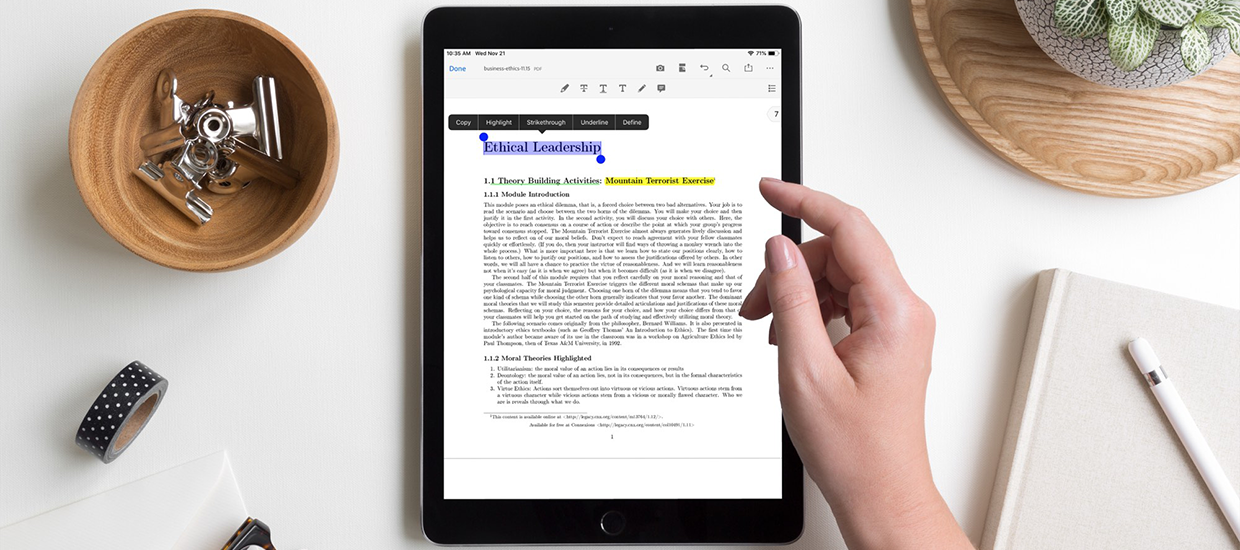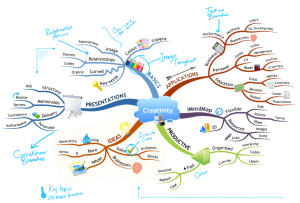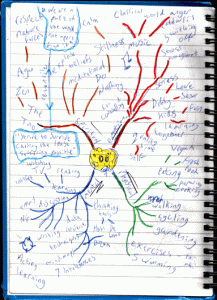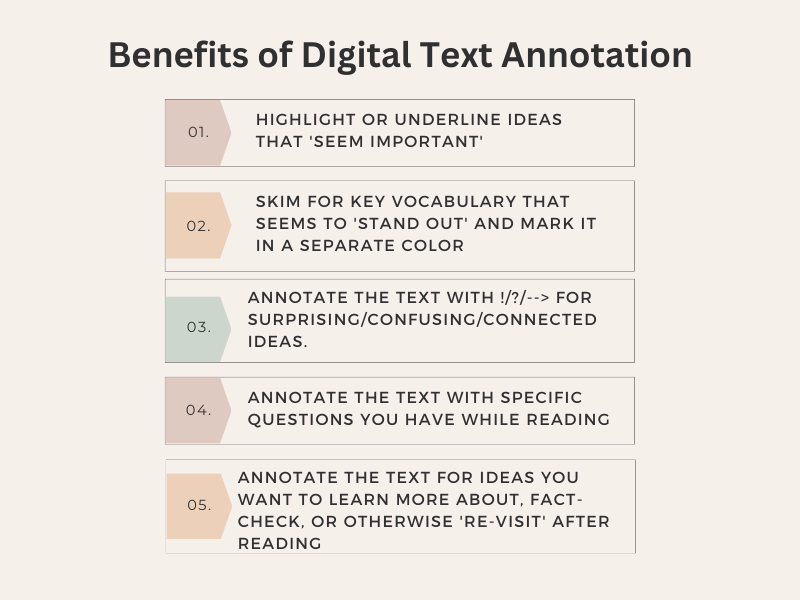19 Digital Annotations: Interacting with the Text Effectively

In ESL 116, our main goal is for you to become effective and efficient readers of academic texts. After previewing an article, we would like you to use these strategies while reading texts intensively:
1. Underlining and Highlighting
Underlining the text allows you to select important sentences at the moment that you are reading the text for the first time. The underlining of sentences should happen consciously; in other words, you should decide carefully whether to underline a sentence or not. To do it effectively, make sure to preview the article before starting the annotation process.
It is very easy to underline excessively without thinking about what you are reading. This is a mistake because you will make the reading task much more difficult, and unnecessarily. You will not detect the main points of the text either. As you read, think about the significance of the ideas that you are reading; for example: Are certain sentences important? Are they worthy of being selected? Are they presenting new ideas? Are they making connections with previous ideas? Are they expressing, perhaps, main ideas? Are they presenting significant examples?
Highlighting is a very common reading technique among U.S. college students. It involves using one color, typically yellow, to highlight sentences that you consider significant in the text. While it is fine to highlight sentences as you are reading the text for the first time (as long as you make a thoughtful decision on what to highlight), it is much better to highlight sentences the second time you are reading the text.
Remember that intensive reading means spending more time on the article, so yes, will need to read academic texts more than once. You may also highlight the text right after finishing reading a paragraph and while you reflect on what phrases or sentences are really important in that particular paragraph. In the end, the text should have underlines and highlights that capture only relevant pieces of information. The purpose is to prepare yourself effectively for those days when you’ll need to study the text for an exam.
Review this example that contains underlines and highlights:
A doctor in the United Kingdom has come out with a bold and extraordinary statement regarding the problem of childhood obesity.
Dr Matthew Capehorn said that parents who had obese children under the age of 12 should be charged with parental neglect, meaning that they could have their kids taken away from them. Dr Capehorn said that in a case where children were seriously under-nourished and had not been fed properly the police and local authorities were allowed to take away the children into care and the same should apply to children who are obese.
Dr Capehorn will be rallying other doctors for support for his proposals at the British Medical Association (BMA) annual conference later in June. Dr Capehorn argues that a child who is clinically obese is at serious risk of health problems which are just as serious as for a child who is malnourished. He said that parents should be educated on how they need to feed their children and given advice about nutrition but if they fail to take this advice the social services should step in and protect the children from their own obesity. The doctor also argued that if parents were made aware that their children could be taken away into care unless they made a serious commitment to their health they might sit up and listen more to nutritionists and people giving dietary advice.
Answer these questions:
- Assuming this passage was read twice, can you predict which annotations were done first? And which one was done during the second reading?
- Compare some of the underlined words and the highlighted words. How do they complement each other?
- Just by glancing at the highlighted words and sentences, verbalize the main ideas of this passage. Divide the passage in half, and take turns doing it with a partner.
2. Margin Notes
Typing comments to the right and left of the text, and at the top and bottom of the page, helps you remember why you highlighted or underlined a text.
Margin notes are comments that you write on the margins of the page. Typically, these comments aim to clarify important ideas that have been underlined or highlighted. They can also include comments on the relationship of the highlighted or underlined passage to the question posed in the assignment, references to other articles that discuss the same issue(s), and personal reactions to the author’s ideas or the reliability of the supporting evidence, just to mention a few examples.
Margin notes can be done digitally, on the screen, or on paper. The example below shows digital margin notes.

On the text, the margin notes should primarily be complementary phrases that clarify the real meaning of the main ideas. When marking up the text, focus primarily on writing complementary and clarifying language rather than questions. We don’t want you to write only questions that do not have immediate answers. As the image above shows, it is possible to include questions or reflections; however, if you encounter a difficult main idea, it is better to paraphrase it and write a margin note.
3. Mind Maps (handwritten)
For a certain type of learner, and for certain types of note-taking or assignments, a more visual style of note-taking may be more effective. Mind mapping is one type of note-taking that sometimes works for these learners/assignments.
Here is an example of a mind map on the topic of “creativity:”

And here is an example of a student’s class notes, using a mind map:

4. Mind Maps (using computer software)
It is also possible to create mind maps on your computer. Here are two websites to generate mind maps:
Homework
For more information on annotating texts, read this page from the University of North Carolina at Chapel Hill


